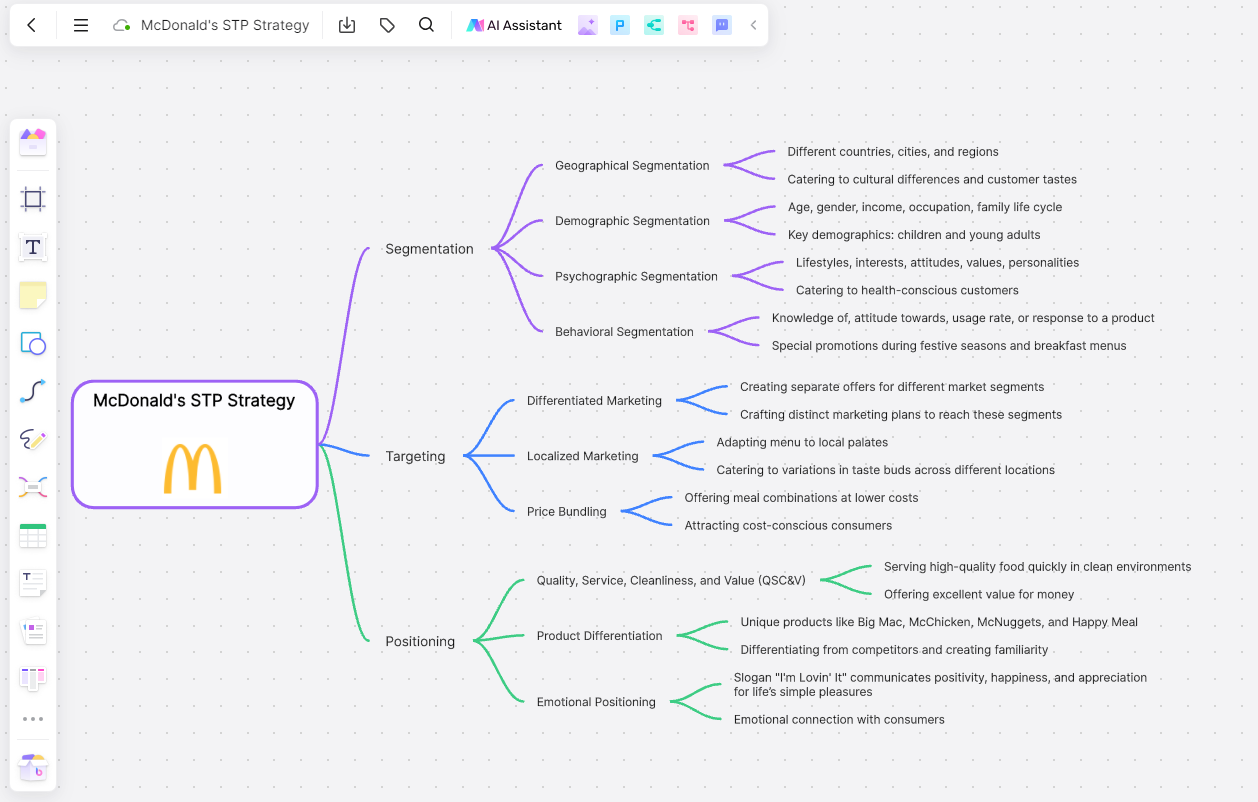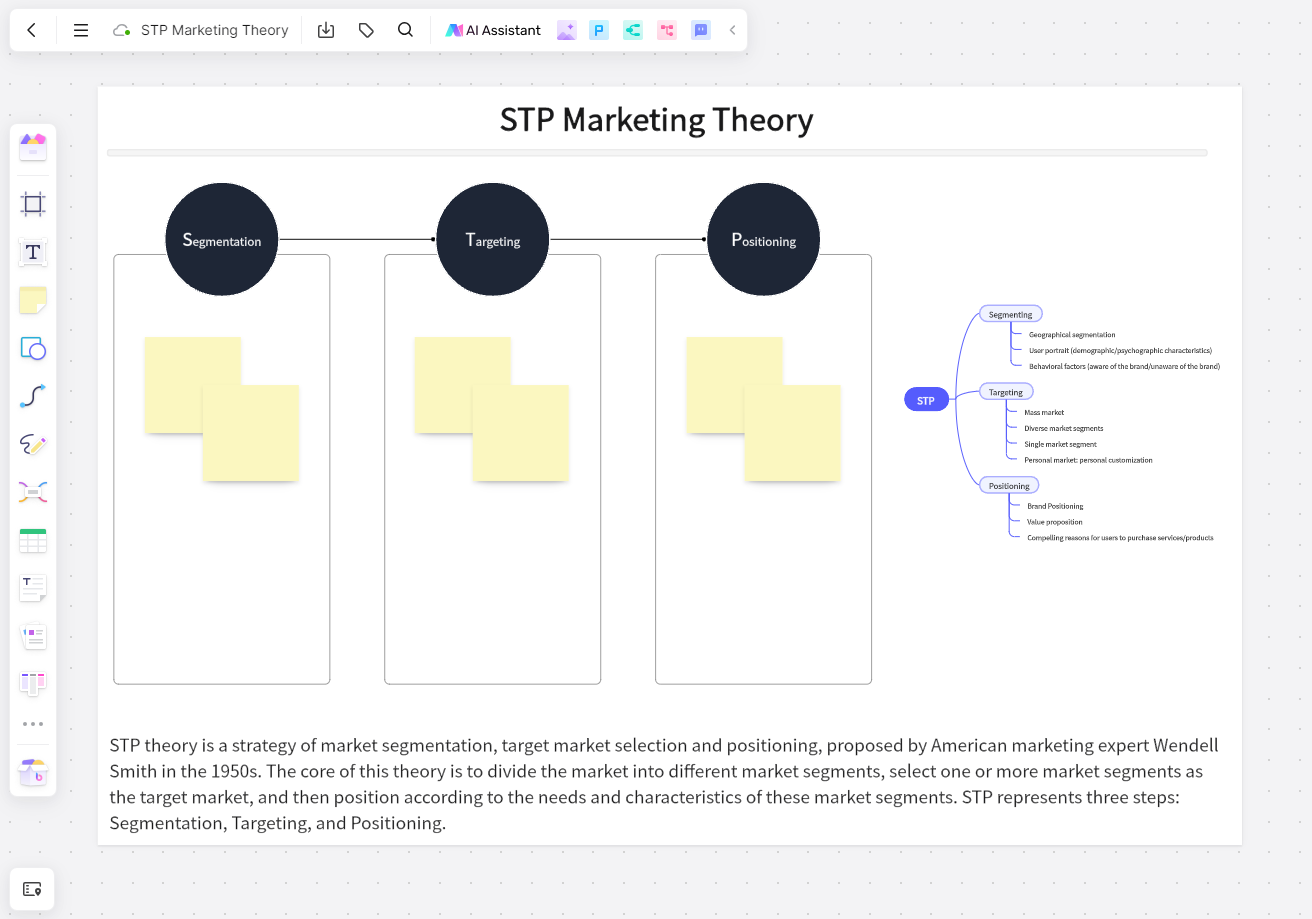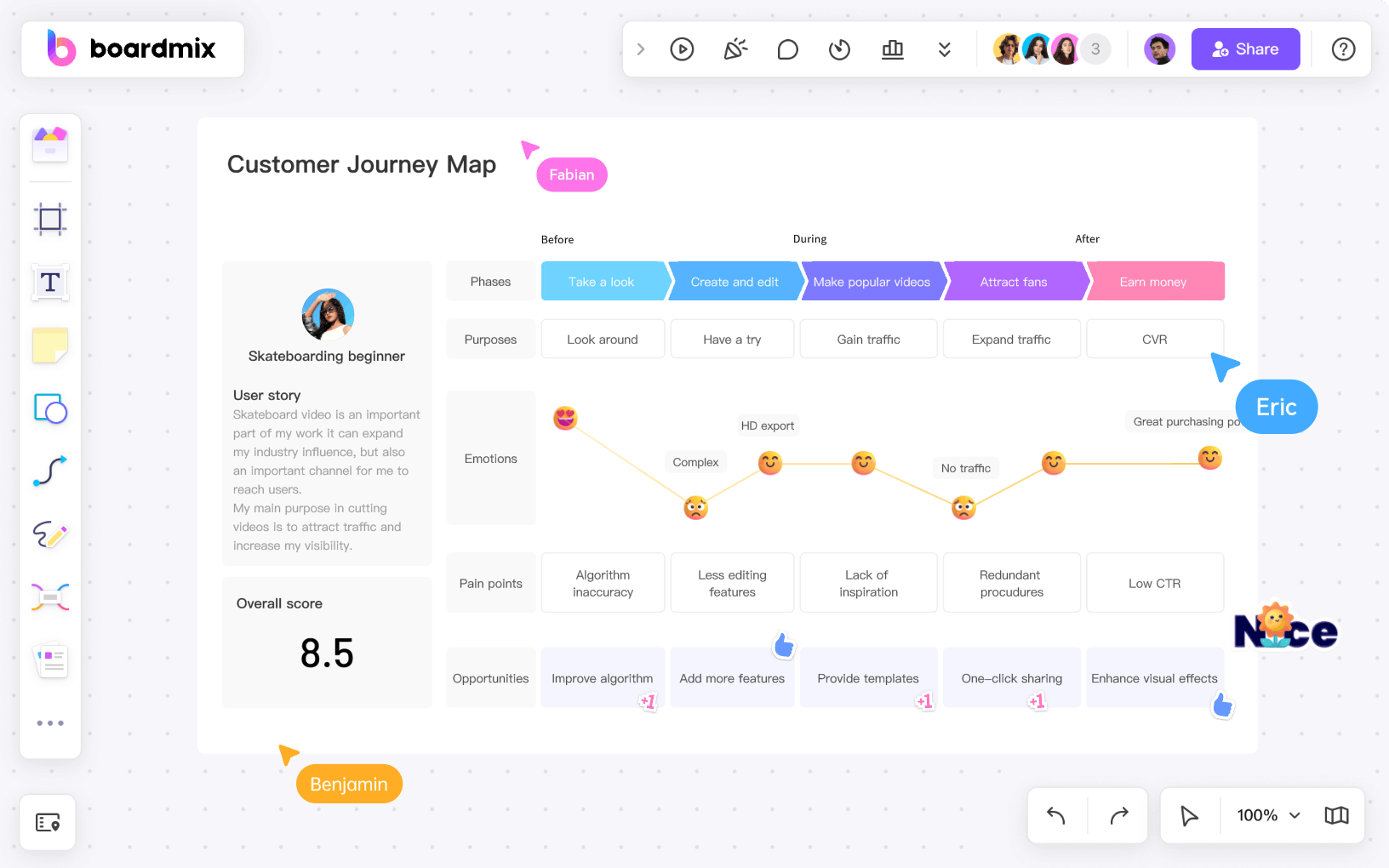In the contemporary, ultra-competitive fast food market, an effective marketing strategy is crucial. At the heart of these marketing efforts lie three interconnected principles: segmentation, targeting, and positioning (STP). The global giant McDonald's offers a textbook example of effective STP strategies in action.
In this comprehensive overview, we delve deep into McDonald's segmentation, targeting, and positioning strategies. We'll also explore the company's market segmentation, targeting tactics, and positioning principles. Finally, you'll be provided with a clear and handy cheat sheet for a quick recall of everything discussed.
McDonald's Segmentation, Targeting, and Positioning Mind Map
The journey through McDonald's STP strategy can be complex. To facilitate an easy understanding, we provide a comprehensive mind map highlighting the key aspects of McDonald's segmentation, targeting, and positioning strategies. This visual aid will serve as your roadmap throughout this article, allowing you to navigate the complexities of these strategies effortlessly.

Market Segmentation of McDonald's
McDonald's market segmentation is undeniably one of the major factors contributing to its international dominance in the fast-food industry. It recognizes the varied needs, preferences, and expectations of consumers across different markets, consequently adopting strategies to cater to these distinctive customer groups. Let’s delve into this intricate strategy by understanding how McDonald's segments its market based on geographical, demographic, psychographic, and behavioral factors.
Geographical Segmentation
Geographically, McDonald's segments its market according to countries, cities, and regions. While it retains its primary brand image globally, McDonald's acknowledges cultural differences and customer tastes in different locations.
For instance, the fast-food chain serves McAloo Tikki in India - a veggie burger catering to the country's largely vegetarian population. In Japan, it offers Teriyaki McBurger, a product suited to local preferences for teriyaki sauce. Meanwhile, in France, McDonald's includes premium items like the McBaguette and Petit Plaisirs (Little Pleasures), appealing to local gourmet sensibilities. These variations reflect McDonald's knack for tailoring its menu according to geographical preferences, thereby catering to a wide range of taste buds worldwide.
Demographic Segmentation
Demographics play an equally critical role in McDonald's market segmentation strategy. Factors like age, gender, income, occupation, and family life cycle are all considered when McDonald's crafts its diverse offerings.
Children form a key demographic segment for McDonald's. With products like Happy Meals featuring popular toys and play zones in its outlets, McDonald's strategically appeals to children and consequently their families. Young adults are another focus demographic for McDonald’s. The McCafe concept targets young adults by offering premium coffee beverages that compete directly with coffee-specialist establishments.
Psychographic Segmentation
Beyond tangible characteristics like geographical location or age group, McDonald's also ventures into psychographic segmentation. This entails diving deeper into consumers' lifestyles, interests, attitudes, values, and personalities.
An excellent example of this is McDonald’s introduction of healthier meal options. Recognizing a global shift towards healthier lifestyles and food choices, the fast-food chain began offering salad options, grilled chicken wraps, and fruit bags on its menu. By catering to health-conscious customers who value nutritious food options, McDonald's demonstrates a keen understanding of varying consumer attitudes and lifestyles.
Behavioral Segmentation
Finally, McDonald's employs behavioral segmentation – categorizing customers based on their knowledge of, attitude towards, usage rate, or response to a product. Special promotions during festive seasons and breakfast menus are classic examples of McDonald's behavioral segmentation approach.
Offering special menus during festivities like Christmas or Chinese New Year caters to customers' inclination towards indulgence during such periods. Similarly, breakfast menus cater to early risers seeking a quick meal to kickstart their day.
Targeting of McDonald's
Once the market has been segmented, the next step in creating an effective marketing strategy involves targeting. Targeting involves choosing specific segments identified through segmentation and developing products and marketing strategies tailored toward them. Let's delve into McDonald's approach to targeting its diverse customer base.
Targeting Through Differentiated Marketing
At the heart of McDonald's success lies its differentiated marketing strategy. Essentially, this involves creating separate offers for different market segments and then crafting distinct marketing plans to reach these segments.
An excellent demonstration of McDonald's differentiated targeting strategy is its focus on families. With offerings such as Happy Meals, which come with toys targeted at children, McDonald's has managed to attract and retain this market segment. By offering something extra - a toy - alongside a meal, McDonald's not only appeals to children but by extension to their families too. This strategy has transformed many McDonald's outlets into family-friendly locations.
Additionally, the creation of McCafe is another remarkable demonstration of McDonald's differentiated targeting strategy. Recognizing that there was an entire segment of coffee drinkers that McDonald’s wasn’t effectively reaching, the fast food giant decided to launch the McCafe in the 1990s. This separate line of premium coffee beverages was aimed at directly competing with other coffee-focused chains. As a result, it attracted a significant market share among young adults and increased overall store traffic.
Targeting Through Localized Marketing
McDonald's also incorporates localized targeting strategies to cater to the tastes and preferences of different geographical regions. It acknowledges the variations in taste buds across different locations and responds by adapting its menu to local palates.
For instance, in India, McDonald’s offers a wide range of vegetarian options and entirely separate cooking areas for vegetarian and non-vegetarian food – a move to cater to the country’s large vegetarian population. In Japan, it caters to the local preference for seafood with items like the Ebi Filet-O (shrimp burger) and Seaweed Shaker Fries. This keen awareness of cultural preferences and localization of its menus allows McDonald’s to successfully target consumers in different geographical markets.
Targeting Through Price Bundling
McDonald’s also uses price bundling as a targeting tactic, offering meal combinations at lower costs to attract cost-conscious consumers. Meal deals like the “Extra Value Meal” or the “Happy Meal” provide customers with a full meal - a burger, fries, and a beverage - at a lower price than if the items were purchased individually. This form of price bundling has proven effective at targeting budget-conscious consumers looking for value for their money.
Positioning of McDonald's
Brand positioning is essentially the way a brand distinguishes itself from competitors in the market and occupies a unique place in the minds of the customers. For McDonald’s, one of the world’s most recognizable brands, its positioning strategy has played a vital role in its global success.
Quality, Service, Cleanliness, and Value (QSC&V)
McDonald’s positions itself around the idea of Quality, Service, Cleanliness, and Value (QSC&V). This mantra represents McDonald's commitment to serving high-quality food quickly in clean environments and at excellent value. It’s these foundational principles that form the cornerstone of McDonald’s unique positioning in the global fast food industry.
Their focus on quality resonates throughout their entire operation - from the quality of ingredients used to the care put into preparing each meal. This commitment is reinforced by service that aims to be efficient and friendly, catering to the convenience and speed that customers seek.
The aspect of cleanliness extends beyond just their restaurants to their environmental responsibilities as well. They’re committed to reducing their environmental footprint and increasing recycling efforts. Lastly, McDonald’s positions itself as a brand that offers great value for money. Regardless of your budget, you’ll always find something to enjoy at McDonald’s.
Product Differentiation: The Unique Selling Proposition
Beyond their QSC&V mantra, McDonald’s has always leveraged its unique products to distinguish itself from its competitors. Iconic menu items like the Big Mac, McChicken, McNuggets, and the Happy Meal are immediately recognizable to consumers worldwide and significantly contribute to McDonald’s unique positioning. These products not only help differentiate McDonald’s from competitors but also create a sense of familiarity and consistency for customers across the globe.
Emotional Positioning: “I’m Lovin’ It”
Another essential facet of McDonald's positioning strategy is emotional positioning. Their globally recognized slogan "I'm Lovin' It" communicates more than just enjoyment of their food; it communicates positivity, happiness, and an appreciation for life’s simple pleasures. This emotional connection transcends mere product offerings and ingrains McDonald's into the daily lives of consumers.
Furthermore, McDonald’s uses its corporate social responsibility initiatives to position itself as a brand that cares about its community and environment. Whether it's through Ronald McDonald House Charities or initiatives like Happy Meal books, McDonald’s portrays itself as an entity that's more than just a fast food chain.
McDonald’s Segmentation, Targeting, and Positioning Cheat Sheet
To condense this plethora of information into an easily digestible format, we present you with a concise cheat sheet summarizing McDonald's segmentation, targeting, and positioning strategies. This cheat sheet will prove invaluable as a quick reference guide to help you recall and apply these principles.

Key Takeaways: Making Brand Positioning Analysis on Boardmix
McDonald's success is largely attributed to its ability to segment its vast market effectively, target its diverse customer base with precision, and position itself uniquely in the minds of its customers. In the world of marketing, success lies not just in having a great product or service, but in understanding your market and positioning yourself uniquely. Learn from McDonald's and conquer your market segment.
To excel in your business ventures, consider using our solution, Boardmix. Our pre-built Market Segmentation Template and STP Analysis Template can serve as your guide in employing effective STP strategies similar to McDonald's.
Understanding your brand's unique position in the market can give your business a competitive edge. Boardmix is an excellent tool for conducting a brand positioning analysis, providing various benefits.

1. Structured Analysis
With Boardmix, you can use or create custom templates for your brand positioning analysis. These templates can guide you through the process, ensuring that all vital factors - such as Unique Selling Proposition (USP), target audience, brand values, brand personality, and key differentiators - are thoroughly addressed.
2. Collaboration
Brand positioning analysis often requires insights from various team members - from marketing to product development. Boardmix's collaboration features make it easy to involve your entire team in the process, facilitating an exchange of ideas and perspectives that can enrich your analysis.
3. Accessibility
With Boardmix, your brand positioning analysis is not just a static document. It's a dynamic resource that's accessible to your team members anytime, anywhere. This makes it easier to keep everyone aligned on your brand's positioning and strategic direction.
4. Iterative Refinement
The market is constantly evolving, and so should your brand positioning. Boardmix makes it easy to update your analysis as your brand grows and the market changes. You can easily add new insights, adjust your strategies, and keep your team informed about these changes.
5. Integrated Feedback
The platform allows stakeholders to provide their feedback directly on the analysis. This integrated feedback system streamlines communication and makes it easier to refine your brand positioning based on valuable input.
6. Historical Reference
Your previous brand positioning analyses on Boardmix can serve as valuable historical references. Comparing your current positioning with past strategies can offer insights into how your brand has evolved.
By facilitating collaboration, structuring analysis, and offering flexibility, Boardmix is a beneficial tool for any company looking to deepen its understanding of its brand positioning.








